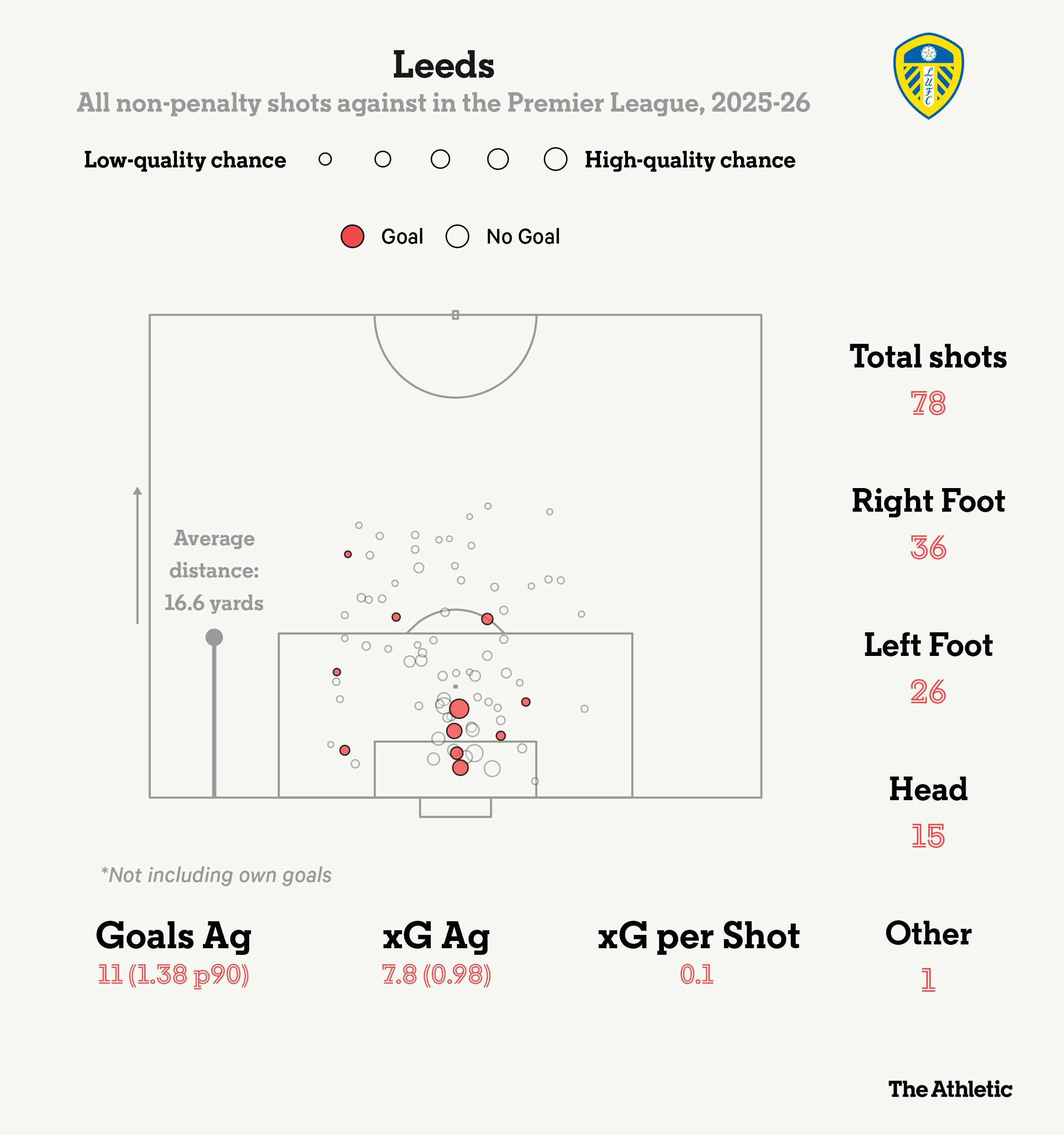“We want to return back to clean sheet behaviour.”
In five consecutive matches, Leeds United have failed not only to keep a clean sheet but to strike first in a game. Daniel Farke’s comment above stood out in his post-match press conference at Burnley.
The newly-promoted side are giving themselves a mountain to climb in every game. Mercifully, and reassuringly, they have shown fight enough in some of their matches to mount comebacks.
Heads could have dropped against Wolverhampton Wanderers, Bournemouth and Tottenham Hotspur, but United equalised in each case and took points from two of the three games. The Fulham concession came too late for a Leeds response, while they never looked like scoring at Turf Moor.
Yes, Farke’s side have to be credited for their mammoth tally of 19 shots, with four on target, four big chances, all missed, and an expected goal (xG) tally of 2.63 against Burnley. Yet, that’s how it felt, an accumulation of low-quality openings nobody had the difference-making ability to convert.
The attention, before the match as well as after, had been on Farke’s attacking starters. With Daniel James, Noah Okafor and Wilfried Gnonto all unable to start in Lancashire, the manager opted to start Jack Harrison and Brenden Aaronson instead of changing his system.
In 12,684 minutes of Premier League football, Harrison has been involved in 44 goals. That’s an average of one every 288 minutes, or a little more than every three full matches played. Aaronson has been involved in four goals across 2,834 top-flight minutes. That means the American has delivered a goal or an assist every 708 minutes, or every seven to eight full matches he completes.
No doubt, updates on the condition of Okafor, Gnonto and James will be of the keenest interest to fans watching Farke’s press conference on Wednesday. However, while eyes are on the attack, the defence has quietly crept up the Premier League’s goals conceded column.
Leeds have now 13 shipped in eight games, with only West Ham United, Wolves, Burnley and Nottingham Forest, the division’s bottom four, worse off. A misfiring attack combined with a leaky defence leads to one outcome next May.
Can Leeds be considered leaky, though? The underlying data is more favourable than you may expect.
Opponents trying to break Leeds down have generated a non-penalty expected goal (npxG) tally of 7.6. Only three teams (Arsenal, Newcastle United and Manchester City) have performed better in limiting opposition attacks.
It’s the same for shots faced, with the 78 Leeds have conceded only bettered by Arsenal (65), Newcastle (75) and Man City (76). So, chances to concede are being limited, but they are still creeping in, or flying in in some cases.

A slightly more refined metric to measure United’s defensive performance is by post-shot expected goals (PSxG). This is expected goals based on how likely the goalkeeper is to save the shot.
This tally, which does include Viktor Gyokeres’s penalty in August, unlike the npxG above, is at 8.2 and down to the sixth-best value in the league. This neatly summarises the depth of the under-performance, too.
Premier League PSxG deficits
Aston Villa
8
7.4
-0.6
Fulham
12
10.4
-0.6
Chelsea
9
8.1
-0.9
Brentford
12
9.2
-1.8
Liverpool
11
9.1
-1.9
West Ham
18
15
-3
Wolves
16
11.9
-3.1
Leeds
13
8.2
-3.8
In short, Leeds should have conceded around eight times in their eight games, but they’ve let in 12 (not including Gabriel Gudmundsson’s own goal). Therefore, the team is 3.8 goals behind where it should be. That’s the worst deficit in the entire league.
It’s a problem, of course, but the hope is, if they continue to be as solid as they have been, the actual goals conceded will revert to the mean. Picking through a selection of the goals can be helpful in at least seeing how differently the outcomes could have been.

The goal, more than any other, which should have been stopped this season, was Antoine Semenyo’s free kick. The winger’s effort was valued at 0.06 PSxG, which means it should only go in six times out of every 100 attempts.
Semenyo’s distance from goal, low shot elevation and sheer quantity of bodies between him and Karl Darlow meant, statistically, it should be saved far more often than not. Aaronson’s positioning as the draught excluder seemed odd, and the wall’s collective jump cleared the way for the ball to fly through.
Of the 13 goals Leeds have conceded, Semenyo’s has the lowest PSxG value. Gyokeres’s first goal and Mathys Tel’s opener for Tottenham had the next lowest ratings at 0.24 PSxG, meaning they should have only scored from their respective positions once in every four attempts.

At the Emirates Stadium, Leeds were found to be playing quite a high line as Riccardo Calafiori clipped a straightforward pass over the top for the Swedish striker to get onto. Even as Gyokeres approaches the area, though, there is a lot for him to do with numerous defenders racing back.
The key moment is as Gyokeres gets through both Pascal Struijk and Jayden Bogle at the same time. He should never have been able to get through their respective challenges.
Even then, his eventual shot has to get through Struijk, Ilia Gruev, Joe Rodon and Calafiori before Lucas Perri gets a look at it. The shot is fortunate to get through, and Perri cannot get a clear look at it through the forest of legs.

Against Tottenham, Sean Longstaff initially miscontrolled a loose ball, which gave Rodrigo Bentancur a chance to steal in. Ethan Ampadu goes to press the Uruguayan, but he is too quick with his lay-off to Mohammed Kudus for the through-ball for Tel.
Tel races with Struijk to the box, takes a touch back, but finds Longstaff arriving, so turns back towards the byline before getting his shot off. You can see how far from goal the striker is, as well as how tight the angle is, with Struijk also there to block.
As we know, it was the defender’s deflection which inadvertently took it past Darlow. Another of the Arsenal goals came in with the fourth-lowest PSxG value.
Bukayo Saka’s strike, on the stroke of half-time to make it 2-0, was valued at 0.26, meaning it too should be saved three times out of four. Gruev’s initial error creates it.

The Bulgarian does well to nick the ball from Arsenal, but, under pressure from Declan Rice, gives it straight to Martin Zubimendi. Players of this quality recognise an opportunity and punish Leeds.
The Spaniard quickly feeds an unmarked Jurrien Timber on the right, who knows Saka will be running in behind for a through-ball. The England international does well to beat Gudmundsson and then rifles the ball from a tight angle, which the xG models would show Perri could have done better with.
Arsenal deserved to win that match, undoubtedly, but the Gyokeres and Saka goals are good examples of how the scoreline arguably flattered the hosts. If Perri saves from Saka or the crowd of legs stops Gyokeres, it changes the dynamic of the match and perceptions of Leeds against the division’s title challengers.
If Semenyo’s goal is stopped, as the data would suggest it should have been, Leeds almost certainly win the game and never fall behind. It’s a similar story with Tel, whose strike broke the deadlock on the day and put the hosts on the back foot.
In a match that Leeds arguably outplayed Tottenham, keeping out Tel changes everything about the flow of the game. These are the fine margins which have worked against a Leeds defence, which has deserved more from the eight games thus far.
It’s a small sample size, and statistics do not provide a firm view of how this season may unfold until December arrives, but, up to now, there remain reasons for optimism in a defensive sense. If Leeds can continue to limit opponents as they have done, the data would suggest clean sheets should not be far away.
If the attack is going to continue to spurn chances, it has to be down to the defence to turn narrow defeats into draws and draws into wins.
